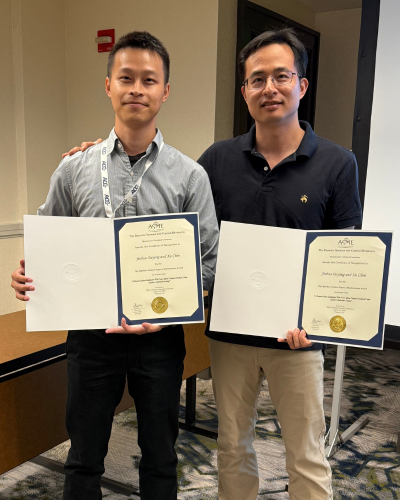September 8, 2025
Jinhua (Toby) Ouyang (MSME ’23) was recently selected as one of two recipients of the 2024 Best Student Paper Award in Mechatronics from the ASME Dynamic Systems and Control Division. Ouyang received the award at the 2025 American Control Conference in Denver, Colorado.

Jinhua (Toby) Ouyang (MSME ’23) and ME Associate Professor Xu Chen at the 2025 American Control Conference.
Co-authored by ME Associate Professor Xu Chen, the award-winning paper is titled "A recursive system identification with non-uniform data under coprime collaborative sensing." The research contributes to establishing a mathematically sound framework for utilizing non-uniform temporal data to model underlying system dynamics.
“We believe that addressing these challenges will inspire new methods and technologies, bringing benefits not only to control and automation but also across a wide range of fields,” says Ouyang, who now works as a research engineer at SC Solutions.
Dynamic systems — or situations where conditions are constantly shifting and hard to predict — with non-uniform data are common in many areas, including manufacturing, robotics, health care, transportation and finance.
For example, with autonomous driving, vehicles rely on data from multiple sensors, such as an inertial measurement unit device, cameras, light detection and ranging (LiDAR), radar and GPS. These data often arrive at different sampling rates and with varying delays, which makes it challenging for classical methods to build accurate models of the vehicle and its environment in real time.
The ME research addresses a longstanding challenge in system identification, or building mathematical models of dynamical systems, under non-uniform sampling conditions when inputs and outputs are sampled at different rates. While data often arrive asynchronously or irregularly, classical system identification methods typically assume that input and output data are sampled synchronously, uniformly and periodically.
By introducing a novel reparameterization framework grounded in number theory, the paper demonstrates a new method for identifying dynamic systems through coprime collaborative sensing, supported by rigorous proofs of identifiability and stability.
“Our method provides a principled approach that leverages the hidden structure in non-uniform data without sacrificing accuracy or reliability,” Ouyang says. “Our framework also allows for data to come from different sources, opening up new possibilities for applying system identification to complex, real-world dynamic systems.”